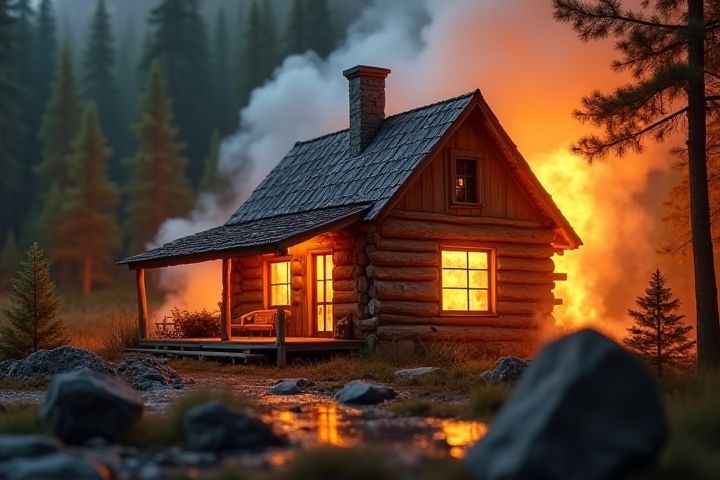
To make a house fireproof, start by using fire-resistant materials for roofing and siding, such as metal or fiber cement. Install double-paned windows, which can resist heat better than single-paned options, and ensure that all door frames are made of solid wood or metal. Create a defensible space around your property by clearing flammable vegetation and debris within at least 30 feet of your home. Equip your house with smoke detectors, fire extinguishers, and sprinkler systems to quickly address potential fires before they escalate. Regular maintenance, including cleaning gutters and inspecting electrical systems, further enhances your home's fire resistance.
How To Make A House Fireproof
Use fire-resistant building materials
Utilizing fire-resistant building materials is crucial for enhancing your home's fire safety. Consider materials such as fiber cement siding, which offers exceptional resistance to fire and can withstand high temperatures up to 1,200degF. Concrete, brick, and stone are also effective choices, as they do not burn and can prevent the spread of flames. When selecting roofing materials, opt for Class A fire-rated options like asphalt shingles or metal roofing that can resist ignition from embers and direct flames.
Install a fire-resistant roof
A fire-resistant roof significantly enhances your home's protection against flames and heat. Opt for materials such as metal, terracotta tiles, or fiberglass asphalt shingles, all of which have high fire ratings. Ensure proper installation to minimize gaps where embers can infiltrate, and consider adding ignition-resistant underlayment for extra safety. Regular inspections and maintenance will help preserve your roof's fire-resistant properties, safeguarding your home from potential fire hazards.
Create a defensible space around the property
Creating a defensible space around your property is crucial for fire prevention, especially in areas prone to wildfires. Aim for a clearance of at least 30 feet from your home, removing flammable vegetation, dead leaves, and debris. In the next 30 to 100 feet, consider using fire-resistant landscaping such as gravel, stone, or low-water plants that are less likely to ignite. By implementing these strategies, you not only enhance your home's protection but also increase its overall safety and value.
Seal gaps and vents
To enhance your home's fire resistance, focus on sealing gaps and vents effectively. Use fire-resistant sealants to fill cracks around windows, doors, and electrical outlets, which can help prevent flames and heat from infiltrating your home. Install fire-rated vents or covers, particularly for attic and crawl space openings, to limit airflow that can fuel a fire while still allowing for ventilation. Regularly inspect these areas, as maintaining an airtight seal is crucial for improving your property's overall fire safety.
Install fire-rated windows and doors
Installing fire-rated windows and doors is an effective way to enhance your home's fire resistance. These specialized doors and windows are constructed from fire-resistant materials, such as tempered glass and metal frames, which can withstand extreme heat and prevent flames from spreading between rooms. Ensure that the fire-rated windows and doors meet local building codes and are certified for their fire resistance rating, which indicates the duration they can endure exposure to fire. By prioritizing these installations, you significantly bolster your home's safety and provide additional time for occupants to escape in the event of a fire.
Maintain a clean and clear landscape
Maintaining a clean and clear landscape around your home is crucial for fire prevention. Keep a defensible space of at least 30 feet between your home and any flammable vegetation, removing dead leaves, twigs, and debris regularly. Trim tree branches that extend within 10 feet of your roof and ensure that shrubs are at least 3 feet away from your house. Creating a gravel or stone barrier can further reduce the risk of fire spreading towards your abode, enhancing overall fire safety.
Use non-combustible insulation
Using non-combustible insulation is a crucial step in making your house fireproof. Materials like rock wool, fiberglass, and cellulose treated with fire retardants offer excellent thermal resistance while being less likely to ignite. Insulating your attic and walls with these materials can significantly slow the spread of flames, providing critical time for escape and response. In fact, homes insulated with non-combustible materials can achieve a Class A fire rating, representing the highest level of fire resistance.
Install fire sprinklers and alarms
Installing fire sprinklers significantly enhances your home's fire safety by automatically detecting and controlling flames. For optimal effectiveness, consider systems that provide coverage across all key areas, with an average installation cost of $1 to $2 per square foot. Complementing this, smoke alarms should be placed in every bedroom and on each level of your home, with a recommended lifespan of 10 years before replacement. Regularly testing these alarms--monthly--and replacing batteries annually can ensure they function correctly, providing crucial early warning in case of a fire.
Regularly check and maintain fire safety systems
Regularly checking and maintaining fire safety systems is crucial for achieving a fireproof home. Ensure smoke detectors are installed in every room and test them monthly, replacing batteries at least once a year. Fire extinguishers should be placed in strategic locations, inspected annually, and replaced if they are more than 12 years old or if the pressure gauge is low. Create and practice an escape plan with your family, emphasizing the importance of knowing two ways out of every room in case of a fire emergency.
Create an emergency evacuation plan
Creating an emergency evacuation plan is essential in ensuring your home is fireproof. Start by mapping out two exit routes from each room, ensuring they are clearly marked and easily accessible. Conduct regular fire drills, ideally once every six months, to familiarize all household members with the plan, which increases your chances of a safe escape in an emergency. Keep a copy of the evacuation plan in a easily accessible location, and consider placing it near fire safety equipment like extinguishers and smoke detectors for quick reference.
